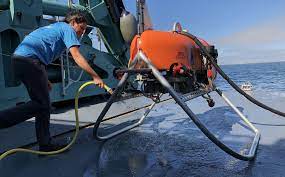At the bottom of the Mariana Trench, at a place called the Challenger Deep near Guam, 36,000 feet beneath the surface of the ocean, the pressures from the water above reach a crushing eight tons per square inch—about a thousand times the standard atmospheric pressure at sea level. Some comparisons ask us to picture 100 adult elephants standing on your head, which would no doubt be painful if you even survived long enough while exposed to that kind of pressure to feel anything at all.
At the Woods Hole Oceanographic Institution (WHOI) in Massachusetts, a small team of scientists and engineers are developing a new class of autonomous robotic systems called Orpheus, named for a figure in Greek mythology who ventured through the depths of Hades. They will soon be able to reach any part of the deepest, darkest reaches of the sea.
The idea is to develop a small fleet of autonomous craft that can stay down for hours, perhaps days, collecting vast amounts of data and samples that will help researchers better understand everything from climate change to how life can survive at such extremes. It’s no wonder that when scientists contemplate the next frontier where such technology might be used, they look to space.
It is believed that if life exists elsewhere in the solar system, it will be found on one of the ice-caked moons of Jupiter (Europa) or Saturn (Enceladus), both of which also have oceans beneath their ice. If there is life, scientists say, most likely it would take the form of microbes like the ones found at great depths in our own oceans. Or maybe there would be something else entirely. A new form of life. We simply have no idea.
NASA is currently contemplating missions to find life on other moons by landing craft and exploring beneath the ice, but they likely remain decades out. In the meantime, as we develop the technology that will be required for a craft to land and submerge in an icy foreign ocean, we are looking to the great depths of our own seas as the closest analog. That work is being done now.
Two Orpheus vehicles have already been built and are being tested at various deep ocean spots around the United States, including a vast, underwater canyon along the New England continental shelf, and off the coast of Florida at a place called the Blake Plateau. Each robot is about the size of a Harley Davidson motorcycle, is shaped like a hoagie sandwich, and costs less than $200,000 to build—far cheaper than other underwater robotic systems with similar capability. They can operate autonomously, which they’ll do at the hadal depths, but can also work while connected to a tether.
The Orpheus project is part of a larger program to explore the deep ocean at WHOI called HADEX, short for Hadal Exploration. The project promises to open up a new frontier in deep ocean science and to help marine biologists better understand how organisms can survive the deep ocean’s crushing pressures. The conditions are so different down there, the adaptations required to survive must also be very different, scientists believe. The exploration of the deepest part of the ocean may lead to the discovery of entirely new life forms, possibly new Kingdoms of life.
Source : https://www.popsci.com/technology/orpheus-underwater-robots/







